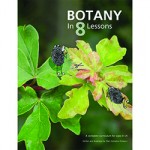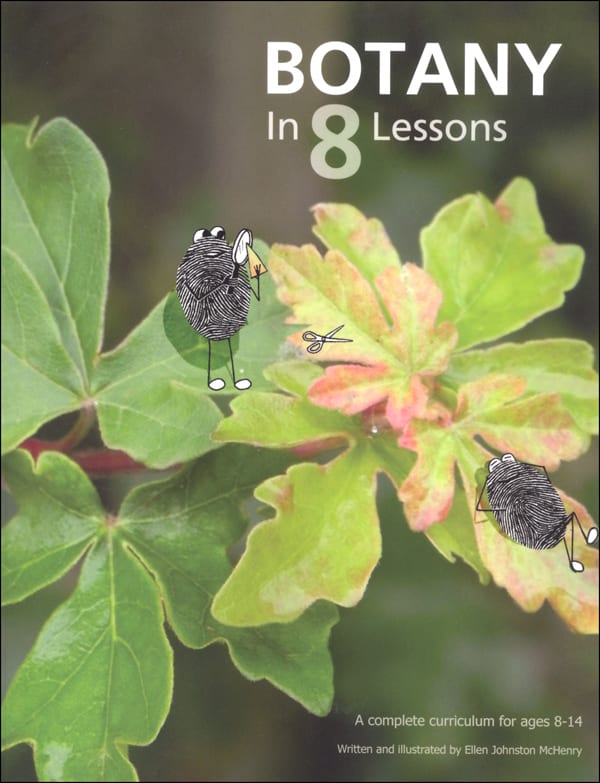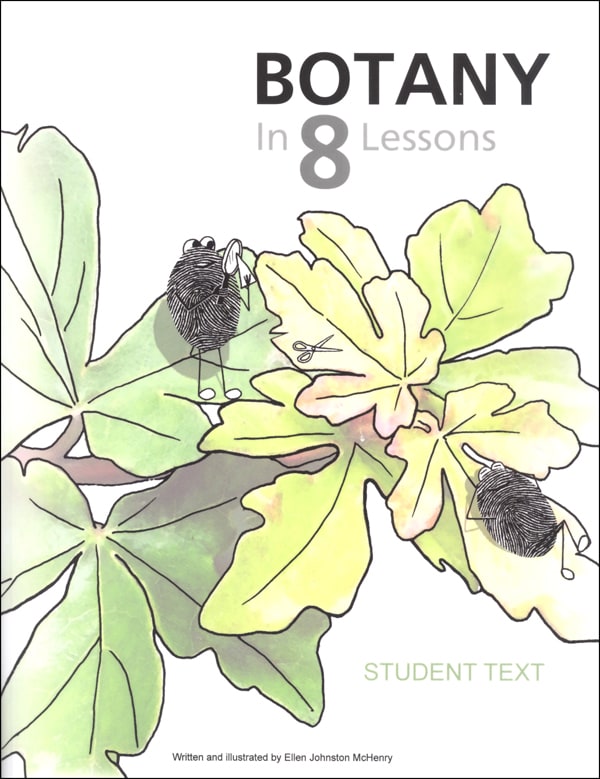In Botany in 8 Lessons, Ellen McHenry teaches serious science to students in grades five through ten, although it might be possible to stretch at least some of the content to accommodate children as young as third grade.
The science content for most topics is quite challenging since much of it can be used for high school credit. To make this understandable for even the youngest students, McHenry provides lots of illustrations (including cartoon drawings) and takes the time to explain and clarify terms. For example, when she introduces monocots and dicots, she says, “Before we go on, let’s talk about these weird names. You may already know that ‘mono’ means ‘one’ and ‘di’ means ‘two.’ But what is a ‘cot’? Sorry to make things more complicated, but ‘cot’ is actually a shortened version of this word: cotyledon(cot-ell-EE-don). Their full names are monocotyledon and dicotyledon. You can see why they usually get shortened to monocot and dicot” (pp. 32-33).
Even though McHenry tries to make the text understandable, she doesn’t shy away from the vocabulary or the concepts. In the first lesson, students learn about photosynthesis, chloroplasts, chlorophyll, the chemical structure of a chlorophyll molecule, the chemical explanation for photosynthesis with molecular diagrams, and much more. To adapt the content for both younger and older students, McHenry splits each of the eight lessons into two parts, labeled Level One and Level Two. Level One lesson material and activities should be completed by all students. Level Two material should be used with older students or those showing an interest or aptitude for going further into the topic. (If you have children in third through fifth grades, you really need to use discretion as to how much of the information you expect them to learn, even with Level One material.)
This course's unusual ability to convey high-level information to students in the elementary grades, derives at least partly from the games, experiments, and activities that reinforce lesson content. Students learn through the hands-on activities as much or more so than from the lesson material itself.
While there are eight lessons, each lesson might take a number of days to complete. For example, the first lesson teaches about both photosynthesis and mitosis for Level One. Level Two continues with a detailed study of the cell, the roll of ATP in photosynthesis, photosystems within plant cells, and the Calvin Cycle—much of this was new material to me! Each section has additional activities. These include answering questions (e.g., matching columns, filling in blanks, identifying true/false answers, labeling drawings), investigating websites for demonstrations or animations (URLs provided), completing crossword puzzles, creating drawings, playing games, performing experiments, and doing research. (An answer key for written activities is included.) Students who like to do arts and crafts should enjoy creating a lapbook using patterns from the book.
All of this makes this a multi-sensory curriculum, but there’s even more. “The Botany Song” and “The Classification Song” are included free with the digital download version (and can also be accessed for free at McHenry's website). Songs are catchy tunes that help students learn the material. Both songs have two versions—one with and one without the vocal track. There is also a playlist of from five to ten YouTube videos for each of the lessons. While all of this hands-on, multi-sensory learning is great for younger students, it might also be the key to success for older learners who still need more hands-on work than is normally provided in their science courses.
Many activities, especially the games, are more suitable for a group class than a single student. You can check some of these out since McHenry makes a number of them available free under the “Free Downloads” section for “Plants” on her website. Some activities follow immediately after each level’s lesson material while others are in the last half of the book. The latter activities are sometimes more appropriate for older students, but even with the age-appropriate activities, you need to select those that seem most useful for your situation. Note, that the games are created from patterns provided in the course, and they will take some work to construct. But they should be well worth the effort.
A six-page Final Review/Test is also included in the back of the book. It’s easy to miss, so take note of where it is if you intend to use it.
Permission is given to copy the activity pages for your family or group class. You can also access the printable pages online at McHenry’s website. Full color is used in a number of instances to make it easier for students to identify details within the illustrations. Some pages to be used for constructing the game are also printed in color. Since the color is important, keep this in mind if you intend to print pages from the digital version or the website. If you are using Botany in 8 Lessons for a group class, you might want to purchase books with only the student text pages rather than complete books for each student or printing from a digital version.
While some junior high and high school students might be able to complete this course on their own (skipping group activities), I think that the course clearly works best when taught by a teacher or parent who can explain or expand upon lesson content when needed and assist with activities. For example, the first lesson uses molecular drawings (including bonds) and conventional abbreviations such as CO2 for carbon dioxide, but there’s really no explanation for those unfamiliar with these. In such cases, the parent or teacher would need to add some explanation. There is no separate teacher manual with additional background information.
McHenry's experience over the years suggests that the ideal audience is probably grades five through eight. Her recent experience teaching high school students with the course affirms that Botany in 8 Lessons is also suitable for a high school life science credit. While the course is probably too difficult for younger children, you might still include them at appropriate points to make this a family study.
The first two chapters are available to preview at the publisher’s website, so you can check it out before purchasing.
I’m impressed with McHenry’s creativity in this course. She comes up with learning activities that make it much easier to master complex scientific vocabulary and concepts. While some parents—especially those with a weak background in biology and chemistry—might find Botany in 8 Lessons overwhelming, others will love it.











